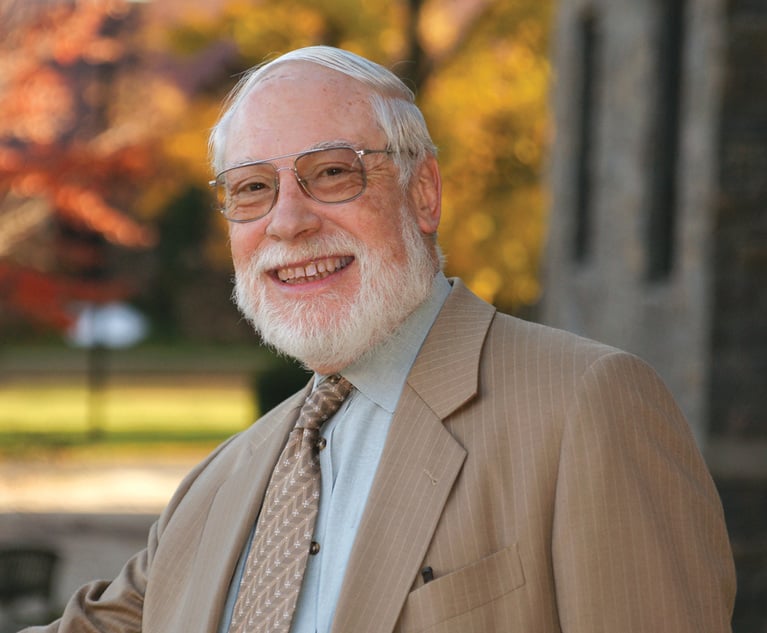Surrogacy: From 'Baby M' to Today's 'Baby-Making Technology'
The law must keep up with the advances in "Baby-Making Technology." Public policy is a moving target.
July 22, 2022 at 02:50 PM
13 minute read
 This is the third in a series of articles that I have co-authored about surrogacy. See Surrogacy in New York: Boon or Bane?, N.Y.L.J. (July 17, 2018; Surrogacy Agreements Approved by New York … With Provisos, N.Y.L.J. (July 24, 2020). In this article, I address Baby M and its legacy, advances in surrogacy that led to New York's enactment of the Child-Parent Security Act, financial and emotional ramifications of surrogacy, and unintended consequences worldwide.
This is the third in a series of articles that I have co-authored about surrogacy. See Surrogacy in New York: Boon or Bane?, N.Y.L.J. (July 17, 2018; Surrogacy Agreements Approved by New York … With Provisos, N.Y.L.J. (July 24, 2020). In this article, I address Baby M and its legacy, advances in surrogacy that led to New York's enactment of the Child-Parent Security Act, financial and emotional ramifications of surrogacy, and unintended consequences worldwide.
Over the past three decades, New York's public policy and attitude about surrogacy has come a long way. The story of surrogacy began with a tragedy—the 1980s case of Baby M (Matter of Baby M., 109 N.J. 296 (1988)) where a traditional, or genetic, surrogacy agreement resulted in a tumultuous lawsuit between the traditional surrogate mother (egg donor) who refused to surrender the baby girl upon her birth (the surrogate mother's egg had been inseminated with the intended father's sperm) and the intended parents. In the aftermath of this case, New York enacted legislation in 1992 prohibiting any kind of surrogacy agreement, as did several other states. All surrogacy arrangements were considered violative of New York's public policy, and commercial surrogacy arrangements (where the surrogate is paid) were frowned upon to such an extent that, pursuant to DRL §123, effective in 1993, all parties involved, including the attorneys, could be subject to civil and/or criminal penalties.
Despite that public policy, by a mere two decades later, it was estimated that several thousand babies were born in the United States via gestational surrogacy every year. Clyde Haberman, Baby M and the Question of Surrogate Motherhood, The N.Y. Times (March 23, 2014). In April 2020, in a reversal of its prior total ban, the New York State Legislature passed the Child Parent Security Act (CPSA) (FCA §581 and subsections) (Gov. Andrew Cuomo signed it into law). New York had been one of three states that still banned surrogacy agreements, along with Louisiana and Michigan. With the enactment of the CPSA, commercial gestational surrogacy would be protected by law, and the gestational surrogate could be compensated. While the CPSA did not extend to or cover traditional or genetic surrogacy, changes in our social, legal, and political landscapes over the decades, as well as medical advances in assisted reproductive technology, mandated the relaxation of the ban and the enactment of a law that would permit gestational surrogacy and protect the gestational surrogate.
This content has been archived. It is available through our partners, LexisNexis® and Bloomberg Law.
To view this content, please continue to their sites.
Not a Lexis Subscriber?
Subscribe Now
Not a Bloomberg Law Subscriber?
Subscribe Now
NOT FOR REPRINT
© 2025 ALM Global, LLC, All Rights Reserved. Request academic re-use from www.copyright.com. All other uses, submit a request to [email protected]. For more information visit Asset & Logo Licensing.
You Might Like
View All
Shifting Sands: May a Court Properly Order the Sale of the Marital Residence During a Divorce’s Pendency?
9 minute read
Trending Stories
- 1Uber Files RICO Suit Against Plaintiff-Side Firms Alleging Fraudulent Injury Claims
- 2The Law Firm Disrupted: Scrutinizing the Elephant More Than the Mouse
- 3Inherent Diminished Value Damages Unavailable to 3rd-Party Claimants, Court Says
- 4Pa. Defense Firm Sued by Client Over Ex-Eagles Player's $43.5M Med Mal Win
- 5Losses Mount at Morris Manning, but Departing Ex-Chair Stays Bullish About His Old Firm's Future
Who Got The Work
J. Brugh Lower of Gibbons has entered an appearance for industrial equipment supplier Devco Corporation in a pending trademark infringement lawsuit. The suit, accusing the defendant of selling knock-off Graco products, was filed Dec. 18 in New Jersey District Court by Rivkin Radler on behalf of Graco Inc. and Graco Minnesota. The case, assigned to U.S. District Judge Zahid N. Quraishi, is 3:24-cv-11294, Graco Inc. et al v. Devco Corporation.
Who Got The Work
Rebecca Maller-Stein and Kent A. Yalowitz of Arnold & Porter Kaye Scholer have entered their appearances for Hanaco Venture Capital and its executives, Lior Prosor and David Frankel, in a pending securities lawsuit. The action, filed on Dec. 24 in New York Southern District Court by Zell, Aron & Co. on behalf of Goldeneye Advisors, accuses the defendants of negligently and fraudulently managing the plaintiff's $1 million investment. The case, assigned to U.S. District Judge Vernon S. Broderick, is 1:24-cv-09918, Goldeneye Advisors, LLC v. Hanaco Venture Capital, Ltd. et al.
Who Got The Work
Attorneys from A&O Shearman has stepped in as defense counsel for Toronto-Dominion Bank and other defendants in a pending securities class action. The suit, filed Dec. 11 in New York Southern District Court by Bleichmar Fonti & Auld, accuses the defendants of concealing the bank's 'pervasive' deficiencies in regards to its compliance with the Bank Secrecy Act and the quality of its anti-money laundering controls. The case, assigned to U.S. District Judge Arun Subramanian, is 1:24-cv-09445, Gonzalez v. The Toronto-Dominion Bank et al.
Who Got The Work
Crown Castle International, a Pennsylvania company providing shared communications infrastructure, has turned to Luke D. Wolf of Gordon Rees Scully Mansukhani to fend off a pending breach-of-contract lawsuit. The court action, filed Nov. 25 in Michigan Eastern District Court by Hooper Hathaway PC on behalf of The Town Residences LLC, accuses Crown Castle of failing to transfer approximately $30,000 in utility payments from T-Mobile in breach of a roof-top lease and assignment agreement. The case, assigned to U.S. District Judge Susan K. Declercq, is 2:24-cv-13131, The Town Residences LLC v. T-Mobile US, Inc. et al.
Who Got The Work
Wilfred P. Coronato and Daniel M. Schwartz of McCarter & English have stepped in as defense counsel to Electrolux Home Products Inc. in a pending product liability lawsuit. The court action, filed Nov. 26 in New York Eastern District Court by Poulos Lopiccolo PC and Nagel Rice LLP on behalf of David Stern, alleges that the defendant's refrigerators’ drawers and shelving repeatedly break and fall apart within months after purchase. The case, assigned to U.S. District Judge Joan M. Azrack, is 2:24-cv-08204, Stern v. Electrolux Home Products, Inc.
Featured Firms
Law Offices of Gary Martin Hays & Associates, P.C.
(470) 294-1674
Law Offices of Mark E. Salomone
(857) 444-6468
Smith & Hassler
(713) 739-1250








